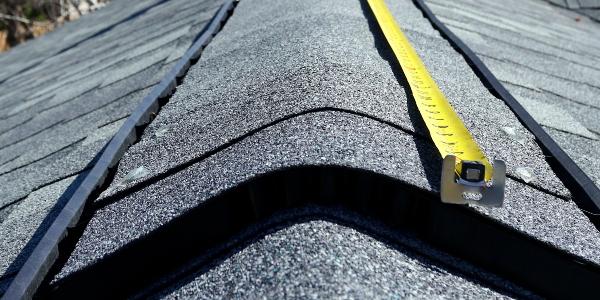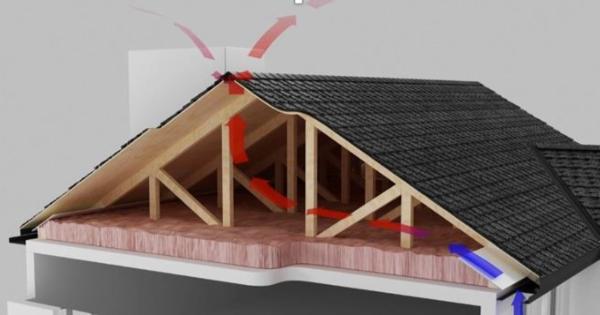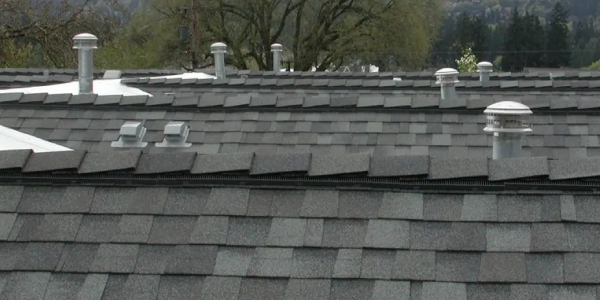Learn why vents are a crucial part of your roof

By Elite Roofing.
Proper roof ventilation can benefit your home in everything from energy efficiency to lifespan of the roof itself. Learn more about roof vents and what you should be looking for.
If you're thinking about installing a new roof or wanting something different, make sure you fully understand the importance of roof ventilation in order to make an informed decision. These vents allow air to move through the attic or roof space of a house. While this may seem counterintuitive to the purpose of a roof — to keep the weather outside — it is crucial to balancing the temperature of your home and preventing moisture from building up, thus extending the roof’s life.
Roof ventilation also has seasonal benefits. In the summer the vents let hot air rise out of your house making your air conditioning system’s job easier and reducing your bill. In the winter, they prevent ice dams from forming and, as they keep moisture from getting trapped, they lower the risk of mold and mildew accumulation. Ultimately, roof ventilation is crucial for your roof and your home.
Choosing the right type of roof vent for your specific needs can be daunting, but taking the time to research and consult a professional will ensure that you have an effective and energy-efficient roofing solution. So, the experts at Elite Roofing put together a quick guide to help you navigate the world of roof ventilation.
Roof ventilation fundamentals
Roof ventilation is essential to maintaining your home’s overall health and efficiency. Proper roof ventilation helps regulate your attic’s temperature, reducing the risk of damage to your roof and improving your home’s energy efficiency.
Types of roof vents
There are several types of roof vents, all designed to promote optimal airflow in your attic. The most common types include soffit vents, gable vents and ridge vents. Soffit vents are on the underside of your home’s eaves, allowing air to enter the attic space. Gable vents, installed on the peak of your home’s gables, work with soffit vents to create a balanced system. Ridge vents run along the ridge of your roof, expelling hot air.
The role of roof ventilation in your home
Roof ventilation serves several important purposes. First, it helps control temperature and humidity levels in your attic, which can extend the life of your roof. By allowing hot air to escape during the summer months, your attic stays cooler and your home’s air conditioning system doesn’t have to work as hard.
In the winter months, proper roof ventilation can prevent the formation of ice dams. These occur when warm air trapped in your attic melts snow on your roof. This melted snow then refreezes at the edge of your roof, causing ice dams. Proper ventilation can prevent ice dams from forming by allowing warm air to escape, protecting your roof and gutters from damage.
Benefits of roof ventilation
There are several benefits to having proper roof ventilation. Some of these include:
- Prolonging the life of your roof by preventing damage from temperature fluctuations and moisture
- Reducing energy costs by helping maintain more consistent indoor temperatures
- Preventing mold and mildew growth that can result from trapped moisture
- Reducing risks of damaging ice dams in the winter months
To ensure the longevity and efficiency of your home, it’s crucial to have a well-ventilated attic. This involves having a combination of intake and exhaust vents, such as soffit and ridge vents, that work together to maintain a continuous flow of fresh air. By doing so, you can keep your home healthy, safe and comfortable year-round.
Purpose and advantages of roof vents
Roof vents are a crucial component of your home’s roofing system. They serve to regulate moisture and heat, making your living space more comfortable while also providing various benefits. This section will outline the primary purposes of roof vents and their advantages.
The primary purpose of roof vents is to remove moisture and condensation from the attic space. Failing to address excess moisture can lead to mold growth, wood rot and other damage to your home. Proper ventilation removes unwanted moisture promptly, preventing potential health hazards and costly repairs.
Another advantage of roof vents is their ability to dissipate heat, enhancing energy efficiency. During hot summer months, an inadequately ventilated attic can hold excessive heat, increasing your home’s cooling load. Roof vents allow warm air to escape, reducing the strain on your air-conditioning system and making it more energy efficient.
Roof vents also help extend the life of your roof. When your attic is well-ventilated, it prevents shingles from becoming excessively hot and warped, thereby increasing your roof’s lifespan.
Components and types of ventilation systems
In your quest to understand the necessity of roof vents and how they help, it’s essential to familiarize yourself with the various components and types of ventilation systems. There are several kinds of roof vents, including ridge vents, soffit vents, turbine vents and gable vents. Each plays a crucial role in maintaining an optimal temperature and moisture balance in your attic.
Ridge vents run along the peak of your roof and allow hot, humid air to escape from the attic. This works particularly well when paired with soffit vents, which draw in fresh, cooler air from the outside. This combination creates a natural circulation of air within your attic, preventing heat and moisture buildup.
Soffit vents are located under the roof’s eaves and help in supplying fresh air to your attic. They work together with ridge vents or other types of exhaust vents, allowing cooler air to enter your attic as the warm air rises and exits through the top vents. Be sure to check your insulation for proper installation and maintain adequate clearance for airflow.
Baffles are essential components in your ventilation system as well. They create a channel along the underside of your roof deck, preventing insulation from limiting the airflow between the soffit vents and ridge vents. Properly installing baffles in your roof system allows for efficient circulation and can prevent common issues like ice dams, mold and roof damage.
A turbine vent is another popular type of roof vent. It is a spinning, dome-shaped vent atop your roof that uses wind power to create a strong suction effect, removing hot air from the attic. While they are efficient and eco-friendly, turbine vents can be more challenging to install and require regular maintenance to ensure they remain functional.
Lastly, gable vents are typically installed at the peak of a roof's gable ends. These vents allow for natural circulation of air, working similarly to ridge and soffit vents by bringing in fresh air and exhausting warm, moist air. Keep in mind, gable vents alone may not provide adequate ventilation, and pairing them with other types of vents can enhance the overall system performance.
Efficacy of roof vents in different climates and weather conditions
Roof vents are essential for maintaining proper air circulation in your attic, which can be especially important in climates with extreme temperatures.
While not a problem in Florida, in regions with heavy snowfall, roof vents can aid in reducing the weight load on your roof. Proper ventilation allows for warm air to escape and cold air to enter, reducing the chances of snow melting and re-freezing. This process lessens the likelihood of damage due to excessive snow and ice accumulation.
During warmer months, roof vents play a critical role in expelling hot, stale air from your attic space. This helps to lower the temperature in your home’s upper levels, reducing the strain on your air conditioning system and promoting energy efficiency.
It’s essential to note that the performance of roof vents can be influenced by the surrounding environment and weather conditions. In areas prone to high winds or heavy rain, roof vents should be adequately sealed and maintained to prevent moisture infiltration and damage.
Roof ventilation and energy savings
A well-ventilated attic space can benefit you in multiple ways. Proper attic ventilation helps maintain a consistent indoor temperature and lower energy costs. This section will explore how roof vents contribute to energy savings.
During hot weather, your attic can become unbearably hot due to the sun’s heat. This trapped heat can radiate through your ceiling, causing your indoor temperature to rise. Your air conditioning system must work harder to maintain a comfortable environment, leading to higher energy costs. By installing roof vents, you allow the hot air to escape from the attic space, thus lessening the burden on your air conditioning system.
Conversely, in colder months, attic ventilation helps prevent moisture buildup in the attic space. If moisture is trapped, it can lead to the growth of mold and mildew, which can compromise the insulation’s effectiveness and the overall structural integrity of your home. Proper ventilation maintains air circulation, preventing moisture buildup and ensuring that your insulation keeps your home warm efficiently.
Additionally, well-ventilated attic space can prolong the life of your roofing materials. Extreme temperature fluctuations and trapped heat can damage shingles, causing them to buckle or crack. By maintaining proper attic ventilation, you can reduce the risk of premature roof deterioration and expensive repairs.
The role of roof vents in preventing damage to building materials and structures
Roof vents play a crucial role in maintaining the health of your building materials and the overall structure of your home. They allow air to circulate and help prevent issues like mold growth, water damage and structural damage.
When your roof is adequately vented, it allows hot air to escape and cool air to enter through soffit vents. This ventilation process prevents the buildup of excess heat and moisture in your attic. Maintaining a proper balance between temperature and humidity allows you to extend the lifespan of your roofing materials such as shingles and roof sheathing.
Asphalt shingles, for example, can be adversely affected by excessive heat. When your attic becomes too hot, it can cause the shingles to curl, crack or lose their protective granules. These issues can shorten the lifespan of your roof, leading to more frequent and costly repairs or replacements.
Proper roof venting also prevents and mitigates the growth of mold. When moisture builds up in your attic due to inadequate ventilation, it creates a prime environment for mold growth. Mold can cause significant damage to your roof sheathing, which may result in costly repairs if left untreated.
Furthermore, proper ventilation helps prevent water damage. By allowing excess moisture to evaporate, you are less likely to experience issues with condensation, ice dams and other water-related problems. This not only protects your roof, but also the structural integrity of your home.
Installation considerations and best practices
When considering the installation of roof vents, you must consider several factors and follow best practices to balance intake and exhaust properly. Proper installation ensures ventilation effectively controls the moisture and temperature in your attic space, thus prolonging the life of your roofing materials.
First, ensure that the intake vents are installed at the eaves, which is where fresh air enters your attic. This creates a constant flow of air and prevents hotspots from forming. Ideally, your intake vents should be equally distributed across the lower sections of the roof plane, and you should verify the required amount of intake ventilation based on your attic’s size and local building codes.
To achieve appropriate balance, the exhaust vents should be positioned close to or at the ridge, as this allows the warm air to easily escape. The amount of exhaust venting should be equal to or slightly less than the intake venting to optimize air circulation. Also, inspect the area around the chimney for proper flashing and venting, as this can be a potential weak spot for moisture intrusion.
If you are in a hurricane- or wildfire-prone area, selecting roof vents designed to withstand extreme weather conditions is critical. Some manufacturers offer vents with additional features, such as hurricane straps or wildfire-resistant materials.
The choice of shingle color can also impact the roof’s overall ventilation performance. Light-colored shingles may help reflect more sunlight, thus reducing heat buildup in the attic. Consider discussing the best shingle color for your specific location and climate with a professional roofer to make an informed decision.
Lastly, always consult the manufacturers’ instructions for specific installation requirements and guidelines and research building science recommendations to verify the type and amount of ventilation necessary for your home’s construction and climate. Utilizing the expertise of a qualified roofer can help ensure proper installation and compliance with local building codes.
The importance of ventilation in crawl spaces
Crawl spaces are often overlooked but are crucial for maintaining a healthy home. Proper ventilation in your crawl spaces can prevent moisture buildup, protecting your home from various issues such as ice dams, water damage and mold.
Ensuring proper ventilation promotes air circulation and prevents stagnant air from accumulating in your crawl spaces. This continuous airflow helps reduce excess humidity, which is the primary cause of moisture-related problems.
Moisture is a common issue faced by homeowners with crawl spaces. An unventilated crawl space retains moisture, leading to various complications. By ventilating these areas, you can effectively keep moisture levels under control and eliminate potential hazards.
Water damage to your home’s foundation, walls and insulation can occur due to excess moisture. A properly ventilated crawl space can reduce the likelihood of water damage by keeping humidity levels in check.
Mold thrives in humid environments, and an unventilated crawl space is an ideal breeding ground. Mold poses many health risks and can cause severe damage to your home. By ventilating the crawl spaces, you create an unfavorable environment for mold growth, keeping your home safe and healthy.
Conclusion
By following these best practices for roof vent installation, you can create an efficient, well-ventilated attic space that will help protect your home and prolong the life of your roofing materials.
Hiring a reputable roofer will make sure that your roof vents are installed correctly.
Original article source: Janney Roofing
Have a question? AskARoofer.
Find your local roofing contractor in the AskARoofer™ Contractor Directory.













Comments
Leave a Reply
Have an account? Login to leave a comment!
Sign In